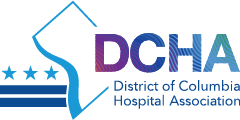DISTRICT OF COLUMBIA HOSPITAL ASSOCIATION GIVES 2019 PATIENT SAFETY & QUALITY AWARDS
On June 6, the District of Columbia Hospital Association (DCHA), awarded its 2019 Patient Safety & Quality Awards recognizing five exceptional individuals and teams in the hospital community. Two individuals and three teams were recognized at DCHA’s Patient Safety and Quality Summit at the Marriott Marquis in D.C.
“We are so pleased to recognize and celebrate individuals and teams for working tirelessly every day on behalf of patients and families,” said DCHA President & CEO Jacqueline D. Bowens, “It’s through the hard work of hospital personnel that help us prepare for a better health care system and outcomes for the residents of D.C.”

The 2019 Patient Safety & Quality Awards were given to:

Dr. Khadijatou Njimoluh, Howard University Hospital, for her creation of multidisciplinary Power Rounds, a unique approach to discussing a patient’s plan of care and discharge. Dr. Njimoluh exhibited key communication components that directly promoted quality and safety for patients. Her creation of multidisciplinary Power Rounds, designed to discuss a patient’s plan of care and discharge, allowed for substantial information sharing which resulted in improved staff communication in line with Howard University Hospital’s Patient Safety goals. The Power Rounds, supported by physicians, nursing staff, social workers, rehabilitation and physical therapists, post-graduate residents and medical students, and of course, patients and family, markedly improved the quality of care during the patient’s stay because of a new way to approach care coordination and decision-making. Dr. Njimoluh accomplishments go beyond just clinical work. Her exceptional ability to communicate and connect to a broad audience is noted daily. She is enthusiastic, culturally sensitive and absorbs knowledge quickly. She possesses exceptional interpersonal skills, is a team player and has a cooperative spirit. Dr. Njimoluh adjusts well, welcomes critique and uses it to elevate her experience during her training. She will undoubtedly excel as she continues to grow in the field of medicine.

Rachel Buckman, MedStar Washington Hospital Center, for her excellence in infection prevention and patient safety. In the three short years that Rachel Buckman has been with MedStar Washington Hospital Center, not only has she excelled in her initial role of infection prevention and reducing CLABSIs, she’s excelled in leading MedStar Washington Hospital Center’s patient safety program. Rachel has recruited and trained new patient safety coaches and introduced many program innovations. Rachel also leads the hospital’s peer review process, hand hygiene compliance program, quality improvement data initiatives, training, wellness and emergency preparedness.Rachel is a superb communicator, with excellent public speaking and writing skills. She often teaches groups and very ably shares the messages she must deliver, to clinical and non-clinical associates as well as to physicians. She is unafraid to speak up for safety and point out missed opportunities in a very professional and polite manner. Rachel is an extremely hard worker, never reluctant to take on new tasks. In fact, on more than one occasion when other associates have left the organization, she has immediately volunteered to assume some of their responsibilities. Her work product is always excellent, very carefully vetted before it’s presented. She is extremely well liked and universally noted to be a “star.”

Clostridium Difficile Prevention Team, MedStar Washington Hospital Center, for their work to drastically lower C. Diff rates, a common hospital-inquired infection. The C. Diff Prevention Team is a multidisciplinary team approach consisting of a physician, nurse, infection preventionists and pharmacist. MedStar Washington Hospital Center’s onset C. Diff rate was persistently higher than goals set both by the Centers for Disease Control and MedStar Health. The work of the C. Diff team created to address the problem and the required process changes, were shared repeatedly with presentations at hospital leadership and staff meetings and on individual units. The team was very diligent about following the C. Diff testing guidelines that had been established. Members of the infection prevention team regularly contacted nurses to discuss C. Diff orders. Members of the executive team conducted “Triple C” rounds with C. Diff, CLABSI, and CAUTI prevention teams and spoke with associates and medical staff on the units about the program. The repeated communication, in various formats, engaged and educated staff, and ultimately inspired the necessary team work to drastically lower C. Diff rates which absolutely contributed to patient safety.

Division of Nursing, MedStar Georgetown University Hospital, for outperforming the national teaching hospital average for injury falls, outpatient falls with injury, hospital acquired pressure ulcers, CLASBI and CAUTI, and prenatal care. The Division of Nursing at MedStar Georgetown has worked hard to have measurable impacts to patients, nursing and the community. For patients, MedStar’s overall patient experience scores outperformed the highest benchmark in the nurse patient relationship, education, efficiency, and pain management. For nurses, successes included providing an environment for autonomy in practice, excellence in nursing leadership, professional development opportunities and nurse-to-nurse interaction. The Division of Nursing’s focus on achievement creates a care environment that goes above and beyond to promote improvement, strengthen care and engage the stakeholders. The proof is in the data. MedStar Georgetown outperformed the national teaching hospital average for injury falls, outpatient falls with injury, hospital acquired pressure ulcers, CLASBI and CAUTI, and prenatal care.

Reducing Vancomycin Use in the Neonatal Intensive Care Unit, Children’s National, for improving the quality of care by reducing vancomycin exposure. Benchmarking data on antibiotic use in 2016 and 2017 showed that vancomycin use in Children’s neonatal intensive care unit was more than three times that of the average level. Prompted by this data, Children’s assembled a multidisciplinary team to reduce vancomycin use by 50% in one year and to sustain for at least one year. The team developed and implemented interventions including clinical practice guidelines, educational initiatives, pharmacist-initiated prompts on rounds to de-escalate or discontinue vancomycin review from the antimicrobial stewardship team, and documentation of blood culture volumes. Within one year, their vancomycin days of therapy per 1,000 patient-days decreased by 60% and this decrease has been sustained for the past six months. The rate of vancomycin-associated acute kidney injury has similarly decreased by 50%. This project improved the quality of care provided at Children’s National by standardizing the approach to several infectious conditions in hospitalized neonates, by integrating pharmacists into antibiotic review, and by improving documentation of volume of blood culture samples. This project improved the safety of our patients by reducing unnecessary vancomycin exposure and by reducing vancomycin associated acute kidney injury.
Individual winners were presented with a $2,500 prize, and teams with a $5,000 prize thanks to support from Ascension. The award winners were chosen out of more than 25 nominees by a panel of independent judges from the health care industry.

















